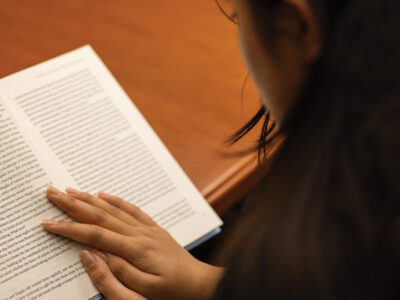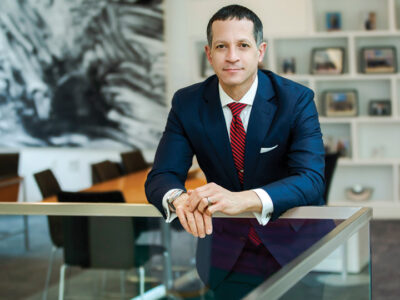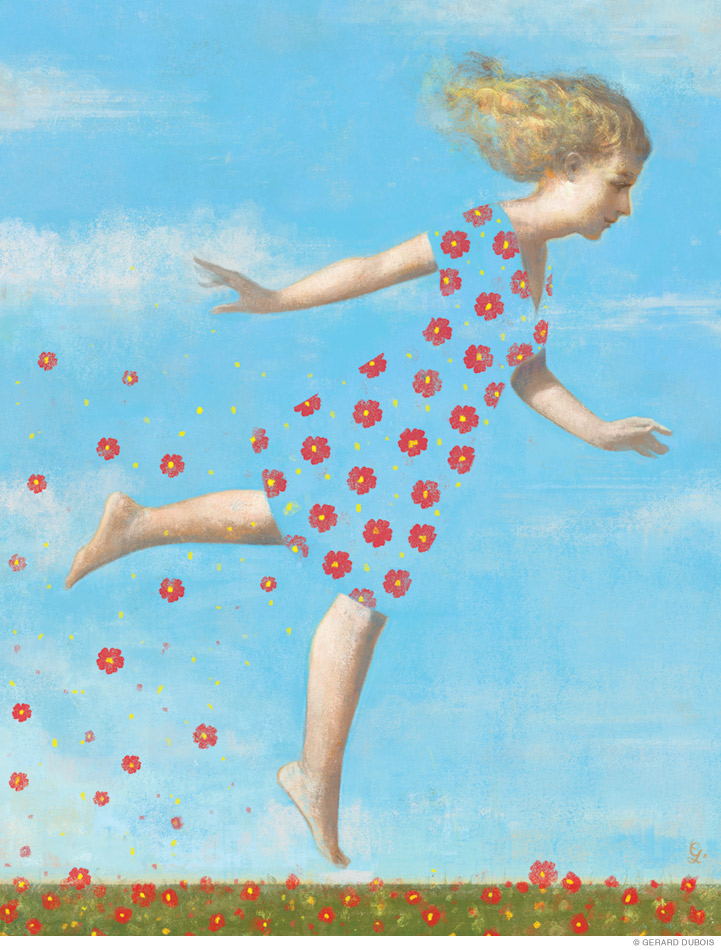
We know what we should do when it comes to leading healthier and happier lives. But too often we default to easier, more pleasurable wants. Behavioral scientist and Wharton professor Katy Milkman is determined to help us change for the better—and for good.
By JoAnn Greco | Illustration by Gérard DuBois
Sidebar | Agents of Change
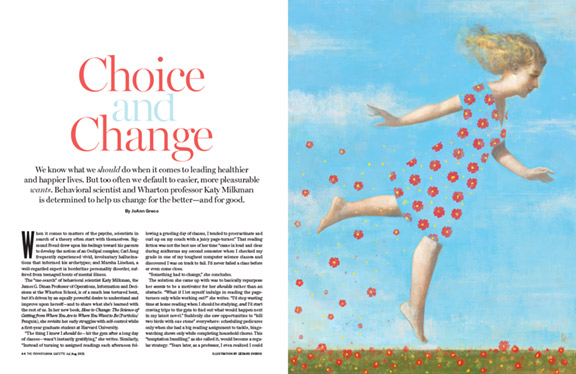
When it comes to matters of the psyche, scientists in search of a theory often start with themselves. Sigmund Freud drew upon his feelings toward his parents to develop the notion of an Oedipal complex; Carl Jung frequently experienced vivid, involuntary hallucinations that informed his archetypes; and Marsha Linehan, a well-regarded expert in borderline personality disorder, suffered from teenaged bouts of mental illness.
The “me-search” of behavioral scientist Katy Milkman, the James G. Dinan Professor of Operations, Information and Decisions at the Wharton School, is of a much less tortured bent, but it’s driven by an equally powerful desire to understand and improve upon herself—and to share what she’s learned with the rest of us. In her new book, How to Change: The Science of Getting from Where You Are to Where You Want to Be (Portfolio/Penguin), she revisits her early struggles with self-control while a first-year graduate student at Harvard University.
“The thing I knew I should do—hit the gym after a long day of classes—wasn’t instantly gratifying,” she writes. Similarly, “Instead of turning to assigned readings each afternoon following a grueling day of classes, I tended to procrastinate and curl up on my couch with a juicy page-turner.” That reading fiction was not the best use of her time “came in loud and clear during midterms my second semester when I checked my grade in one of my toughest computer science classes and discovered I was on track to fail. I’d never failed a class before or even come close.
“Something had to change,” she concludes.
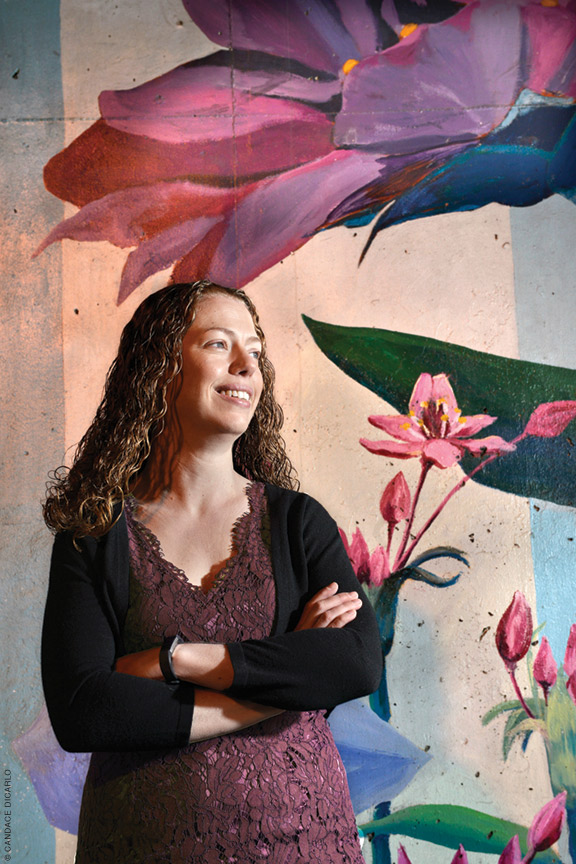
Photograph by Candace diCarlo
The solution she came up with was to basically repurpose her wants to be a motivator for her shoulds rather than an obstacle. “What if I let myself indulge in reading the page-turners only while working out?” she writes. “I’d stop wasting time at home reading when I should be studying, and I’d start craving trips to the gym to find out what would happen next in my latest novel.” Suddenly she saw opportunities to “kill two birds with one stone” everywhere: scheduling pedicures only when she had a big reading assignment to tackle, binge-watching shows only while completing household chores. This “temptation bundling,” as she called it, would become a regular strategy: “Years later, as a professor, I even realized I could eat less junk food if visits to my favorite burger joint were reserved for mentoring sessions with a difficult student [whom] I knew I should see more often.”
In the foreword to How to Change, Angela Duckworth Gr’06 [“Character’s Content,” May|Jun 2012], the Rosa Lee and Egbert Chang Professor of Psychology and author of Grit: The Power and Passion of Perseverance, writes that Milkman“copes with the same fallibilities we all share. … [She] has learned that the secret to a better life is not to eradicate the impulses that make us human but instead to understand them, outsmart them, and whenever possible, to make them work for us rather than against us.”
“Katy’s desire to use science to help people live better lives is completely authentic,” says Duckworth, a frequent collaborator who calls Milkman her “academic sister and BFF.”
Milkman organizes her first book around seven stumbling blocks—including impulsivity, laziness, and lack of confidence—that she says get in the way of good decision-making. “The surest path to success is not one-size-fits-all,” she writes. “[Y]ou’ll get further faster if you customize your strategy: isolate the weakness preventing progress, and then pounce.” (See page 49 for some examples.)
Even when we know better, Milkman emphasizes, we still can make poor decisions—because people don’t always act predictably, or rationally. “Every day is a series of decisions, and so many of the outcomes in our lives are the sum of our choices,” she says during a video chat. “There’s a whole field in economics and decision science about rational decisions, too, but to me it’s less interesting to find the ways that people do things really well. To the extent that you care about social impact and making the world a better place, then there’s this natural opportunity when you say, ‘Oh! here’s all the mistakes that we make! Let’s see what we can do about that.’”
She cites behavioral economist Richard Thaler—and particularly his groundbreaking 2008 book, written with Cass R. Sunstein, Nudge: Improving Decisions About Health, Wealth and Happiness—as her main influence. “Thaler basically says that if it’s established that people are suboptimal decision makers, then they could probably use a little help making better decisions. Why not try to do that in a way that will maximize well-being?” she says. “That way of thinking laid the foundation for everything I do.”
“I’ve always been a bit of an oddball,” Milkman says.
The focus of her work is applied behavioral science, but she is neither a psychologist nor an economist by training, instead coming to the field from a background in operations management and computer science. Her research spans several disciplines, and she publishes regularly in journals focused on economics, management, psychology, marketing, and medicine—and once in the journal of Literary and Linguistic Computing, she says.
But Milkman doesn’t limit herself to traditional academic publishing. She writes op-eds; makes herself available as an expert resource for reporters; and has hosted Choiceology, a podcast from financial services firm Charles Schwab, since 2018. Writing the book was an opportunity to spread the word even more widely. “When I was a senior in college, I signed up for a journalism seminar,” Milkman recalls. “Everyone in the class wanted to be a journalist—except me. I wanted to be a scientist who communicates about science.”
It wasn’t until shortly after her arrival at Penn in 2009 that Milkman’s intellectual “north star” truly emerged. A newly minted assistant professor, she wandered over to a seminar at the Perelman School of Medicine (where she now holds a secondary faculty appointment) to attend a presentation. She was particularly struck by a pie chart that broke out the different causes of premature death. One wedge was for decisions that could be changed. “I would have assumed that was just a small fraction—but it was 40 percent. What we eat, what we drink, whether we smoke, whether we’re active, whether we buckle our seatbelts. It was this light bulb moment,” she says.
Milkman first made her mark while still an undergraduate with a quantitative analysis of the fiction published in the New Yorker magazine, and in her PhD dissertation, she compared how long people held onto their DVD rentals for lowbrow and highbrow films (the former got watched—and returned—sooner). At Penn, she coauthored a study with Wharton colleague Jonah Berger, associate professor of marketing, on what kind of articles in the New York Times got forwarded most often (stories of uplift and inspiration led the list), which is still among her most frequently cited papers.
“I had fun with those questions,” Milkman says now, “but it was this realization that if I could apply my research to trying to improve outcomes, I might have some positive impact. So, my work since then has focused on [things like] figuring out ways to help people make healthier choices around their exercise, whether or not to get vaccines, savings decisions, [and] helping kids study and do better in school.”
Behavior Change for Good (BCFG), an initiative she and Duckworth cofounded, is allowing Milkman to tackle those issues on a larger scale than ever. The two are faculty codirectors, with Milkman taking the lead in research on savings and health and Duckworth focusing on education. A collaboration between Wharton and the School of Arts and Sciences, BCFG is a multidisciplinary effort to understand and improve human behavior involving about 100 international experts from multiple institutions representing neuroscience, behavioral economics, psychology, medicine, communications, and data science. The group includes two Nobel Prize winners and five MacArthur Foundation “geniuses,” one of whom is Duckworth [“Gazetteer,” Nov|Dec 2013].
At the core of the effort is the mega study, a type of large field experiment that is new to behavioral science—though a similar approach has been used productively in artificial intelligence and machine learning experiments, Milkman explained in an online presentation from BCFG in November. “In that arena, you would have researchers competing to solve the very same problem—say, image recognition—subject to the very same constraints. Everybody is working with the very same data set,” she said. “You can really see, ‘Oh wow, this algorithm really outperforms these others,’ because of that common task framework—and so we’re trying to bring that idea into behavioral science.”
Interest has been growing among policymakers in using the insights of behavioral science, Milkman said in the presentation, with hundreds of “Nudge Units” being established at institutions around the world over the last decade or so. “There’s just tons of appetite for applied behavioral science solutions to policy problems. But how do we get those good solutions?” Ideally, policy advice should be based on field experiments, since it’s only “in the wild” that scientists can assess whether and how much a given intervention affects behavior, and measure factors like cost effectiveness.
But running field experiments traditionally has involved large fixed costs, and the process of validating an idea can be time consuming. Even when data are available, looking at studies with different variables and populations often requires “apples versus oranges comparisons,” Milkman added. And as with other fields, behavioral science research faces the “replication crisis” and “file drawer problem,” meaning the failure to produce consistent results from similar studies and to publish at all about unsuccessful studies, respectively. As a result, “it’s not always clear which behavioral insights will be robust,” she said, “and we may expend huge amounts of resources to try to replicate others’ failures without knowing it.”
The mega study approach avoids these drawbacks. “A mega study is a very large field experiment in which many smaller sub experiments are synchronously run with the very same dependent variable,” Milkman said. “Instead of having, you know, two experimental conditions, you have more like 50 experimental conditions and many hypotheses tested simultaneously.”
This removes the apples-to-oranges problem, while the fixed costs of executing the study can be borne by a central organizer, which “really lowers the marginal cost for individual scientists.” With so many experiments being run at once, it’s unlikely that nothing will be found that’s effective, “and it also eliminates the file drawer problem, because you can publish all of the results together and the nulls are just as interesting in that context as the successes.”
Mega studies also produce a lot more data for “behavioral phenotyping,” she added, explaining it as a “nerdy medical term for basically figuring out what works for whom.” In most traditional studies of one hypothesis being tested, you might be able to tease out that something worked better for women than men, for example, “but you don’t really understand.” By testing 20 different interventions, “I can find out which one is the very best for women, which ones are very best for men, and other subgroups and so on,” she said. “The wider your trial, the more experimental conditions, the more you can do this.”
Overall, the use of mega studies “just vastly accelerates the pace of scientific discovery relative to the usual one-at-a-time processes we’re used to.” Though the large numbers do mean limited opportunity to talk with or closely watch participants and a lack of flexibilityandvariety in the kinds of tests that can be employed, she adds.
“The broad-based experiments that Katy is doing require a lot of coordination and are of a scale that allows us to burrow down and identify small differences,” says Milkman’s departmental colleague Maurice Schweitzer G’91 GrW’93, the Cecilia Yen Koo Professor at Wharton. “That type of scholarship in judgment and decision-making has really distinguished her in the field. She’s been very entrepreneurial in her ability to leverage partnerships and build bridges by collaborating with large organizations.”
In one (pre-COVID) mega study, BCFG recruited nearly 63,000 members of the national gym chain 24 Hour Fitness to participate in a free 28-day program to test which of 50-plus, randomly assigned methods, designed by 30 different scientists, worked best to boost attendance. All told, nearly half of the methods increased weekly gym visits (by a range of 9–27 percent) for four weeks.
While gym attendance has not been top-of-mind lately, another mega study examined the more timely question of encouraging vaccinations. In partnership with Walmart, BCFG and Penn Medicine’s Nudge Unit tested nearly two dozen text-based messages aimed at prompting approximately 700,000 of the store’s pharmacy customers to get their flu shot. Designed to close the gap between intentions and actions, the messages played on psychological traits like “loss aversion” to encourage people who said they wanted the vaccine to actually go get it rather than try to convince anyone who was ambivalent. Tactics included commitment (nudging people to text “I will get a flu shot” to their pharmacy), information (flu season is upon us), and motivation (asking people to encourage others to get shots by copying and pasting a message).
The results revealed that communications like reminders that a flu shot was “waiting” proved most effective, increasing vaccination adoption by up to 11 percent. A separate study of nearly 50,000 patients of the Penn Medicine and Geisinger Health systems yielded strikingly similar results. “Our results suggest a promising way to encourage COVID-19 vaccinations at scale,” Milkman said when the study’s results were released earlier this winter. “We can potentially help save lives for less than 10 cents per person.”
In May, as daily vaccination rates were down from their early spring peaks, Milkman published an op-ed in the Washington Post—coauthored with Duckworth and Mitesh Patel, director of the Penn Medicine Nudge Unit and the Ralph Muller Presidential Professor at the Perelman School—touting the advantages of the text-based approach. “Compared with other tactics, including glitzy ad campaigns and cash incentives, strategies based on text messaging are virtually costless. Yet they move the needle (literally). And unlike mandates, nudges preserve the autonomy of individuals to make their own decisions,” they wrote. “And as we think about vaccine nudges and incentives, let’s remember that they can have a snowball effect. Momentum builds, as more and more Americans can say to one another: ‘Yes, I’ve been vaccinated.’ After all, nothing changes a person’s mind like altering what the crowd around them is doing.”
Milkman regularly incorporates a case study of this bit of human nature into her classes—with her students as the subjects. As she recounts in How to Change, “One day every February, the packed lecture hall where I teach my Wharton MBAs erupts with the cheers of enthusiastic twenty somethings. Full-grown men and women leap from their seats, hooting and hollering like they’re at Mardi Gras. … [They] are responding exactly how I asked them to in an email sent the night before.” Received by all but three students, the email requests that, when she shows a picture of the school’s dean in her slideshow, everyone applaud furiously. At class the next day she watches as the three clueless students dutifully stand and cheer along with everyone else. Why? she asks one. “I just clapped because everyone else did,” the student will inevitably reply. It’s a harmless experiment, she points out, but it demonstrates the power of conforming to social norms, a key driver in decision-making.
“I like to set up challenges or puzzles in every class,” Milkman says. She speaks rapidly, the velocity of her words punctuated by high-spirited laughter. Sharp and funny, she’s a hit with students. Poets & Quants, an online publication that covers the graduate business education market, listed her as one of the World’s 40 Best Business School Professors Under 40 in 2011. (Now 39, she’d still qualify, but at the time she was 28.) In 2013, she was voted that year’s “Iron Chef” by MBA students, beating out other faculty pitching their research in five-minute presentations. (According to the recap in Wharton Magazine, she went with the study bundling pleasure reading with exercise.)
She’s repeatedly been a finalist for the school’s Helen Kardon Moss Anvil Award for most outstanding MBA teacher, and in 2017 was named to the Evan C. Thompson Endowed Term Chair for Excellence in Teaching, established in 2003 to recognize teaching excellence. “I think students like that if they ask me a weird question, I can give an hour lecture because I know this stuff so well,” she laughs. “I’m getting to teach exactly what I study, and they respond to that.”
But growing up in Washington, DC, Milkman didn’t imagine herself at the front of a lecture hall. “I think my high school teachers would be, like, ‘You turned into a professor?’” she says incredulously.
Her mother, a senior executive in procurement for the federal government, was an avid reader, and her father was an engineer (as were both of her grandfathers). Education was prized at home, and while Milkman grew to love books and numbers, nothing really lit her fire academically. She was more interested in tennis, where she was ranked among the top 150 junior women’s players. “I got out of school and went straight to the tennis academy and played for three or four hours. I got home, ate dinner, and was exhausted,” she recalls.
She still did well enough to gain admission to Princeton, entering as an economics major and intending to pursue a career in finance. But Econ 101, as taught by a very well-known economist whom she now admires, soon disenchanted her. “It wasn’t just his dull teaching,” she says. “I didn’t resonate with the model. It was taught as ‘we’re all optimizing, we’re perfect decision- makers’ and I was, like, what is this garbage? Aren’t we human?”
She quit economics (and tennis). Soon after that she met a fellow student at Princeton, Cullen Blake, who was majoring in astrophysics and, unlike her, “had known he wanted to be a professor since he was 13,” she says with a laugh. “I fell in love with him and then fell in love with science. Though not his kind. I was more interested in people and wanted to understand weird things about human nature.”
They would wind up moving on to Harvard together for their PhDs, getting married, and having a child, Cormac, who is now five. When Milkman came to Penn, so did Blake. An associate professor in the department of physics and astronomy, he spends his days, says Milkman, “looking for life on other planets and building cool gizmos.”
Before all that, though, having left economics Milkman had to settle on another undergraduate major. She returned to her familial roots and switched to operations research and financial engineering, with a minor in American Studies, “to have an excuse to read fiction.” Required to touch upon both her major and her minor for her senior thesis, Milkman thought, what a weird set of interests to combine.
Which is how she found herself spending a year reading 450 New Yorker short stories and cataloging their authors by gender, religion, race, age, and native geographical regions. Along the way, she met a handful of New Yorker legends (including Roger Angell, who befriended her) and caught the attention of New York Times media columnist David Carr. He wrote an article on her study that appeared the day Milkman graduated from Princeton, noting that it was “long on statistics and short on epiphanies: one main conclusion was that male editors generally publish male authors who write about male characters.”
It wasn’t the answers that mattered but the way they were arrived at. Not only did Milkman create data where none had existed, but her study was fun; it attempted to quantify something a certain set of people might idly find themselves pondering. One of those people was Max Bazerman W’76, the Jesse Isidor Straus Professor of Business Administration at Harvard University.
He remembered Milkman and her thesis when they met at Harvard, which she had selected for graduate school because of a new interdisciplinary program that combined computer science and business. Sensing that she was floundering during her first year, Bazerman invited her to join his lab group for a discussion and pizza later that evening at his house. “From that point on, she was a central part of the group,” he says. “Her ability to see connections and opportunities to collect and analyze data in ways that I wouldn’t have thought about was phenomenal. It’s unusual to have a colleague in a young student who knows stuff that you don’t.”
Bazerman—whose work focuses on negotiation, behavioral economics, and ethics and who had been publishing in management journals on what he termed the “want–should” conflict since the early 1990s—became Milkman’s doctoral advisor. As Milkman shifted direction once again, she encountered this and other concepts that would become key in her current work. Later, she’d wind up enlisting many of these thinkers into BCFG. People like the persuasion expert Robert Cialdini; Thaler of Nudge fame; and the psychologist and economist Daniel Kahneman, winner of the Nobel Prize and author of Thinking Fast and Slow, who had first challenged traditional economic theory about the predictable patterns of buyers and sellers.
“I was, like, ‘Whoa, this is so interesting!” Milkman says. “Where has this been all my life?” (Ironically, Kahneman was teaching at Princeton while she was a student there, but she never took a class with him, thinking, “Psychology? That sounds like baloney. I’m a math person!”)
In How to Change, Milkman shares the stories of real people and the psychological barriers that prevent them following through on their good intentions. She then unpacks the big data behind the tactics that can work to break down those obstacles. Often, she draws from her own research and experiments. In the book’s first chapter, she addresses the question of finding the impetus to simply get started on a behavioral change. Challenging the view of economic theory that “our preferences remain stable over time unless we face changing circumstances, such as new constraints, new information, or a price shock that forces an adjustment to our beliefs or budget,” Milkman set up a project to “identify other moments that provoke the same reaction and to understand how and why they can unstick us and motivate change.”
She and her collaborators sent out letters featuring bright red proclamations to thousands of Penn employees urging them to save for retirement. “In addition to the option to start saving immediately, we offered some people the chance to start saving at a later date,” she writes. “For some it was a fresh start date—after their next birthday or at the start of spring. Others [received] an arbitrary, unlabeled further date or an upcoming holiday without fresh start connotations, such as Martin Luther King Jr. Day.” The “fresh start” messages turned out to be 20–30 percent more effective.
Throughout the book, Milkman freely admits she hasn’t completely mastered her own foibles. “Whether it’s scheduling a dental checkup, voting, texting a friend a birthday message, or even recalling where I put my keys, you can be sure I’ll drop a ball (or several) every day of the week,” she writes in her chapter on forgetfulness. And, as evidenced in conversation, she’s subject to self-doubt, another one of the obstacles spotlighted in How to Change, fretting that the title sounds a little too much like “another of those yellow books for dummies.”
But with media outlets from Bloomberg to Wired and influencers from Silicon Valley venture capitalist and marketing guru Guy Kawasaki to bestselling Happiness Project author and podcaster Gretchen Rubin spotlightingthe book, it’s clear that Milkman has hit a post-COVID nerve. (If ever there was a time for a fresh start, she says, it’s now.)
How to Change earned a spot on the Wall Street Journal’s Bestselling Hardcover Business Book list a week after its release, and Milkman has been powering through several podcast and print interviews a day, while continuing to conduct research and meet with her students. “I like days that are packed,” she says. “I like being around people and thinking on my feet.” (“There’s working at human speed, and then there’s the speed of Katy,” observes Duckworth, who’s no slouch herself.)
To blow off steam and help keep fitness and family time in the mix, she’s been taking a 45-minute walk around the neighborhood almost every day with her husband and young son. It began during the pandemic—“checking out the window boxes, the delivery people, the squirrels”—but amidst the whirlwind of attention, it’s been a lifesaver, she says. “I’m a big fan of exercise as a way to feel better, think better, have better conversations.”
More than a decade after that pie chart opened her eyes, she still wakes up “curious about what I’m going to do,” she continues, “but now I also feel that there’s this broader mission behind the work. As a social scientist, I can’t cure cancer or solve the climate crisis, but I think finding out what creates lasting behavior change is also critical and—”
She stops as five-year-old Cormac excitedly bursts into the room, back home from visiting his grandparents. “Mommy’s just about to finish up,” Milkman reassures him as he leans his curly head against hers. “That’s OK,” he says. “I have things to do, I have things to make!” She laughs, then finishes her thought. “There are so many lives that could be extended and whose quality could be improved if we better understood how to help people achieve their own goals when it comes to savings, diet, education, exercise.”
Cormac squirms and giggles and she says, “I should run …” As Zoom fatigue sets in, it seems that for now her shoulds and her wants are perfectly aligned.
Agents of Change
In her new book How to Change, Wharton’s Katy Milkman emphasizes that what’s holding you back may not be the same as what’s getting in the way of your best friend. But in this lightning round, we brought up some general goals and asked her to offer tactics that might turn common foibles (in bold) into agents of change.
I can’t stick to a diet. If laziness is the problem, take advantage of that trait by changing your environmental defaults, Milkman says. “Purge all of those tempting snacks from your fridge or your pantry so the path of least resistance will be to grab (hopefully tasty) substitutes like smoothies or nuts.”
I never call my mom. You think about it, plenty, but then it slips your mind. Tackle forgetfulness by “being more deliberate and making a plan in a systematic way,” Milkman says. “What are the cues that will remind you to make the call?” A pledge like “When ___ happens, I will ___,” with the blanks filled in as specifically and in as detailed a fashion as possible, might help.
I hate housekeeping! Temptation bundling is one way to make an unpleasant task palatable, as Milkman notes in her book. But if it’s getting started that overwhelms you, she recommends looking at the fresh start effect. How about spending just 30 minutes after dinner every Sunday night, before the work week gets underway?
I’d like to be more involved in my community. Try to “copy and paste,” as Milkman calls it, the best practice actions of a social leader or friend. This plays on a penchant for conformity. “It’s important to be in good company when you hope to achieve big goals,” Milkman writes in the book.
I wish I spoke up more at work. Lack of confidence can hold us back in all kinds of ways. Consider forming an advice club with friends or colleagues who are struggling with the same issue, she suggests. Not only will you benefit, but giving solicited feedback to others has been shown to boost your own confidence. —
JoAnn Greco writes frequently for the Gazette.



